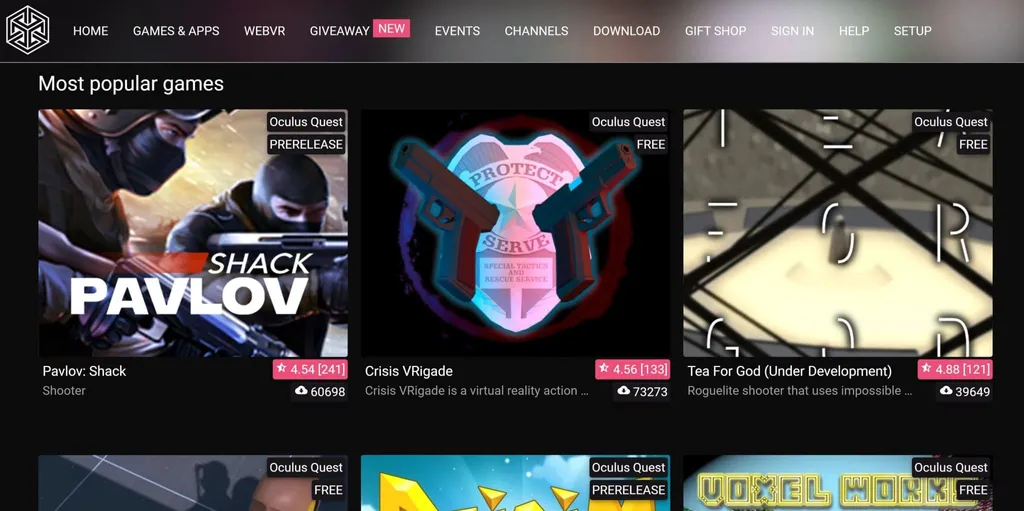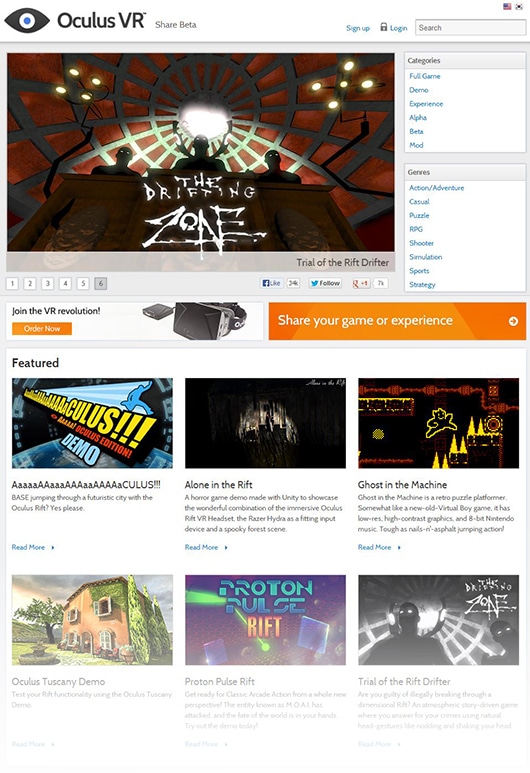The generally positive reception for Oculus Quest in its first year has been helped in subtle but significant ways by the existence of SideQuest.
This is a tricky position to take because Facebook won’t share how many Quests sold and the majority of Quest owners likely don’t even know SideQuest exists. Given these conditions, how can SideQuest be helping the standalone system and contributing to its success?
Curation’s Limits
SideQuest shares a lot in common with the earliest days of Oculus Share. Oculus announced Share in August 2013, before the startup was acquired by Facebook in 2014, and the blog post at the time stated “we’ll be vetting submissions to make sure the content isn’t offensive or malicious.”
Around six years later, with some founders of Oculus gone, Facebook opted for a curation policy on its Oculus Quest storefront for the standalone VR headset that would “ensure that the contents of our storefront are consistently high quality.” When I reported that in February last year, a few months before Quest launched, a Facebook representative reinforced they “don’t intend to shut down sharing of builds amongst friends” and they still believe there’s “massive value” in “early experimentation.” At the time, however, they said they had no early access program for Quest.
The curation strategy appears to have worked. The content you can buy from the Oculus store is generally top notch, executives said they’ve been making the headset as fast as they can sell it, and most important, we hear some developers are finding some of the steadiest sales on Quest of any VR platform.
And over that same time SideQuest effectively became Quest’s early access program.
Early Experimentation On Standalone
Over the course of Quest’s life, SideQuest proved itself as an important part of the VR market.
Downloading videos and photos captured on Quest is easier with SideQuest and it became the home of a much-loved Virtual Desktop feature rejected by Facebook, delivering wireless PC VR games streaming several months before the wired Oculus Link shipped. Pavlov Shack built out a multiplayer community via an early release on SideQuest, and an experimental modification brought the original Half-Life game to wireless VR.
Perhaps most important, in December when Facebook launched its experimental controller-free hand-tracking development kit SideQuest immediately became home to a bunch of small demos of the input system. While hand tracking gave a bunch of people who opened Quests on Christmas morning an unexpected and neat feature to play with, through Oculus, you could only really interact with the system’s menus in the open air. But via SideQuest, a number of controller-free hand tracking demos were widely available within days of Facebook rolling out the tools to make the software. This period of rapid iteration and instant feedback encouraged creators to continue their exploration on Quest.
Dev Kits And Openness
Late last year Facebook revealed it would start targeting ads against activity in Oculus VR headsets. At the same time, the company also tied certain built-in social functions of the headset to its “real” identity policy. Neither of these policies is much a surprise, but they do form the basis of the most common criticism we hear relative to Oculus headsets. Namely, that they come with Facebook attached to critical features.
From the earliest days of Oculus Share it was common to show a friend or family member a mind-blowing virtual world and then find yourself in a conversation about how the world might change if the technology becomes commonplace. Will people stop going outside? What does it mean to let a single company intermediate human interactions to such a degree? In the early days those conversations were always paired with explanations about why this might be a few years off still; consumer VR requires a $1,000 computer, you have to run a bunch of cords around your house, the apps aren’t great yet.
Quest Changed The Conversation
The technical and cost-related parts of the conversation were erased by Oculus Quest. Beat Saber, Superhot VR and Pistol Whip are all amazing pieces of software that shine so brightly on the wireless Quest. What’s left, then, is a conversation about giving Facebook too much power and the uncomfortable feeling left in our stomachs seeing what happened as a result of so many years of letting companies — especially Facebook — use our information in ways that were opaque to us.
This conversation often concludes in Facebook’s favor partially because of SideQuest. Every Quest sold is also a developer kit and you can become an Oculus VR developer almost as easily as you can make a new Facebook account. It is free and you just fill out a few fields of information. Afterward, you can add whatever you want to Oculus Quest — whether it be your own creation, something from SideQuest or an Android software package sent to you directly by a friend.
SideQuest’s Strength
So even if you don’t use SideQuest and even if you don’t know that it exists, the fact that it does is evidence to an argument that Facebook’s VR platform is “open”. It refutes the idea that Facebook’s Quest is the same as a closed console. Sure, you can’t jailbreak it, run your own operating system, or modify the hardware in the same way you can a PC, but you can also become a developer for free in less than 15 minutes and install something without a central authority stopping you.
What Oculus Share was to the VR market in 2013 and 2014, SideQuest is in 2019 and 2020 — a place where experimentation and sharing thrive. SideQuest of course has its own standards in what it accepts onto its platform, but these standards appear much closer to those of Oculus Share from 2013 than Facebook of today. Plus, SideQuest makes it very easy to install any Android-based software package you want regardless of what the people who run it determine is appropriate for them to carry. The overall effect of this platform is that it returns Facebook’s Oculus efforts to that sense of hope which drove so many into enthusiasm around VR in the first place.
SideQuest doesn’t erase fear related to the idea that Facebook is going to win the race to become the dominant VR platform, and what it could do with direct access to your eyeballs, ears, and behavior. It does, however, convince some people to give Facebook a chance to live up to its promises.
Changing Expectations
Many people out there paid $400 or $500 to Facebook to purchase a Quest. Those same people likely used Facebook on a daily basis for a decade or more, and for a large group of them, buying a Quest is likely the first time they’ve ever actually bought something from the company.
Facebook needed Quest to change its relationship to the world and a great many people are giving them that chance. SideQuest and its avenue allowing some Quest owners and developers to experiment on the standalone system is evidence Facebook is at least trying to change. Quest is a great VR console without SideQuest, but locking down the platform to the degree that you need sign-off from a developer relations team in Silicon Valley, and requiring you hand over a large percentage of revenue for your idea to Facebook, would have been a step too far. Oculus Quest and Facebook’s VR efforts would have been subject to far more criticism without SideQuest, and its existence is helping more people dive into VR development and discover the true potential of an all-in-one VR system.
Facebook may not have needed an early access program to sell a lot of Quests in the first year, but it did need SideQuest to assure a growing number of developers the platform was open enough to be interesting.





























